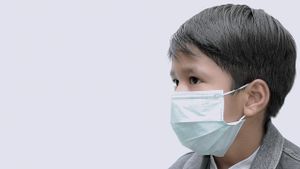
JAKARTA - Healing, healing, healing, billing. The pressure of urban life is getting higher. Staying sane is a necessity. We know it by the term healing. As the law in economics, where there is a need, there is commodification. Interesting.
The long discussion about healing found its exciting point. Within a week, Twitter was enlivened by the exposure of two healing mediums. First, Breakroom. Breakroom Exposure originally happened on TikTok. The @tassy.sy account uploaded a video of two people in protective suits and faceshields.
In the video the two are standing in a special room. They destroyed a number of items, from glass bottles to television tubes. Quoted from Hai Online, Breakroom Manager Sisca Febriana explained that Breakroom was deliberately made for self-healing medium.
The breakroom, which is located on Jalan Muara Karang Barat Number 41 RT/1 RW 8, Peluit Penjaringan, North Jakarta, has been running since 2019. The idea of establishing a Breakroom emerged through research on the behavior of the people of Jakarta whose stress levels tend to be high.
"As we all know, the population of Jakarta in particular, which numbers more than ten million people with the majority of them working, coupled with the traffic jams here, causes mental stress or mental burden and higher emotional levels," said Sisca.
For those who need healing, has anyone tried this Breakroom in North Jakarta? Starting from IDR 100,000 per person per 20 minutes. The room is air-conditioned and is said to be private. Is there CCTV in it? Cr: tiktok https://t.co/viMoYlVvem pic.twitter.com/FTIWpTyTGn
— pancasyah (@pancasyah) November 22, 2021
While managing Breakroom, Sisca observed the condition with her eyes. He saw so many ways people express emotions. Some shouted. Others throw, slam, and hit the items provided.
"Well, here we provide a more private outlet, of course without hurting other people. You can beat things with all your strength while releasing anger too. It's okay to cry as loud as you can," added Sisca.
Besides Breakroom, another business that is being discussed is Kokuo Massage & Reflexology. Kokuo's exposure was warmly welcomed after the Twitter account @xdyrara uploaded a video of Kokuo's service. "Is this the peak of self-healing in the style of the citizens of the Capital City?" write @xdyrara in the upload,
Jakarta residents' stress levelIs this the pinnacle of self-healing in the style of the citizens of the capital? pic.twitter.com/YVxCbBC9Mo
— ANDY (@xdyrarara) November 23, 2021

The latest report, The Least and Most Stressful Cities Index 2021, puts Jakarta on the list of the ten cities with the highest stress levels. The capital city occupies the bottom ninth position, with a score of 41.8 on a scale of 0-100 points.
The lower the score of a city, the higher the stress level. The score is obtained by a number of indicators.
For example, the number of safety and security reached 46.7 points. For social and political stability, Jakarta is at 44.7 points.
The next indicator is gender equality and minorities in the Capital City, with scores of 59.8 points and 34 points, respectively. The assessment also highlights the population density of DKI Jakarta, which in the report was recorded at up to 4,733 people per square kilometer.
Another is the level of traffic congestion, which is scored 41.5 points. The lowest score recorded for Jakarta is noise pollution: 25.4 points.

The Least and Most Stressful Cities Index 2021 ranks one of India's major cities, Mumbai as the city with the highest stress level in the world. Mumbai only has a final score of one point. Slightly better than Mumbai is Lagos.
The city in Nigeria got a score of 19.9 points. In Southeast Asia, the Philippines is the city with the most stress levels, with a score of 29.4 points.
Reported by Databoks, The Least and Most Stressful Cities Index 2021 report analyzes one hundred world cities. The cities are categorized into four sections: government, cities, finance, and public health. The four categories are further divided into 16 factors, ranging from governance, social pressure, to the impact of the Covid-19 coronavirus pandemic.
Stress commodification
The commodification of stress is not a new concept. The DNA of the tourism industry, one of which is here for it. Clinical psychologist and author of Psychodynamic Perspectives on Aging and Illnes, Dr. Tamara McClintock Greenberg explains why travel is good for mental health.
According to him, the pressures and demands of daily work can shift our judgment towards what is truly meaningful and interesting. So taking a break from the hustle and bustle of everyday life is very important to restore a relaxed mind.
Traveling makes us happy and helps us take our mind off stressful situations. In a more mindfulness stage, traveling also “helps us reflect on our goals and personal interests.”
Business and marketing analyst, Yuswohady, in his 2020 tourism outlook classified the tourism sector which will grow during the pandemic. He calls it NEWA, an acronym for nature, eco, wellness, and adventure.

This is in line with the Ministry of Tourism and Creative Economy (Kemenparekraf). The Ministry of Tourism and Creative Economy for the past few years has built city pilots with the concept of a wellness city. Some cities and regions that have been processed are Yogyakarta, Bali, and Toba.
"I am also now helping in Banyuwangi to develop the wellness tourism potential," said Yuswohady, contacted by VOI, Friday, November 26.
Even so, Yuswody saw that this project was not enough to answer the community's need for healing. What is important to grow now are oases for the community to escape from the fatigue of routine, which means that these locations must be accessible.
"Actually, tourism can be once a month, once a year. But what worries me is the place for the oasis, which is close by, which is in the city."
Places like Breakroom and Kokuo filled that void. Such as malls, coffee shops, and city parks. Breakroom is present as a tourist destination that is wellness or mindfulness.
Even so, Yuswohady sees that Breakroom and Kokuo will not become a massive industry because of their non-mainstream and even extreme nature. This is in contrast to malls, coffee shops, and city parks, which are more normal in nature.
"I don't think it will be mass. It means that it might exist, but maybe it's something new. This is a temporary trend, I think. But something that is a bit mainstream, which is not extreme. I don't think it will be mass, huh."
"But in cities I think that are more mainstream, there will be more urban parks. In SCBD or office areas, these oases will appear, which will provide physical experiences to offset those digital experiences."
Yes. According to Yuswohady, from a business perspective, the industry is now increasingly looking at healing needs. Changes in people's lifestyles that are closer to gadgets and farther away with physical experience provide new space for the development of the mindfulness business sector.
"This digital experience will become mainstream. The trigger is indeed a pandemic. But after the pandemic, people will be more comfortable working in this pattern. It will become the new normal. So later the work will be hybrid. The trend will be there."
"Automatically, when he spends a lot of time with screens and wandering in the digital world, that's what I think creates an imbalance between physical and digital experiences. So that's what disturbs our mindfulness, right. So the industry will grow."
*Read other information about BUSINESS or read other interesting articles from Yudhistira Mahabharata.
Other BERNASThe English, Chinese, Japanese, Arabic, and French versions are automatically generated by the AI. So there may still be inaccuracies in translating, please always see Indonesian as our main language. (system supported by DigitalSiber.id)








